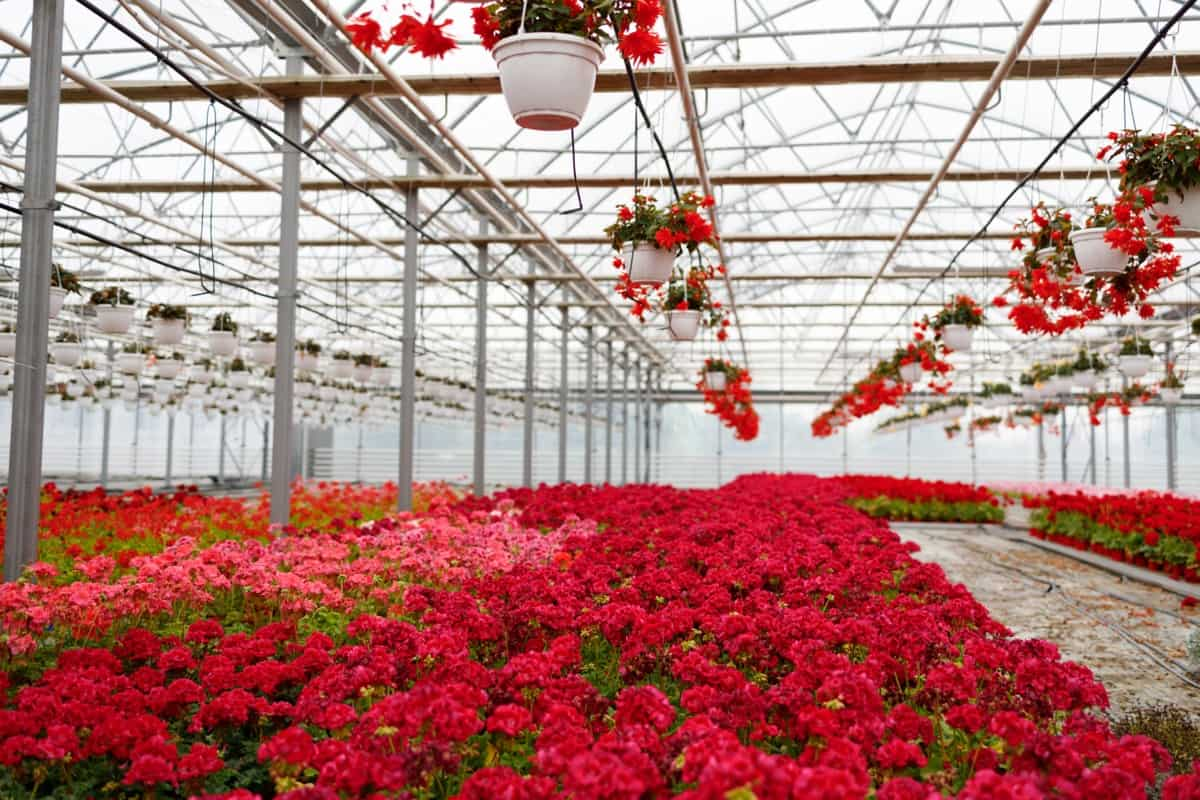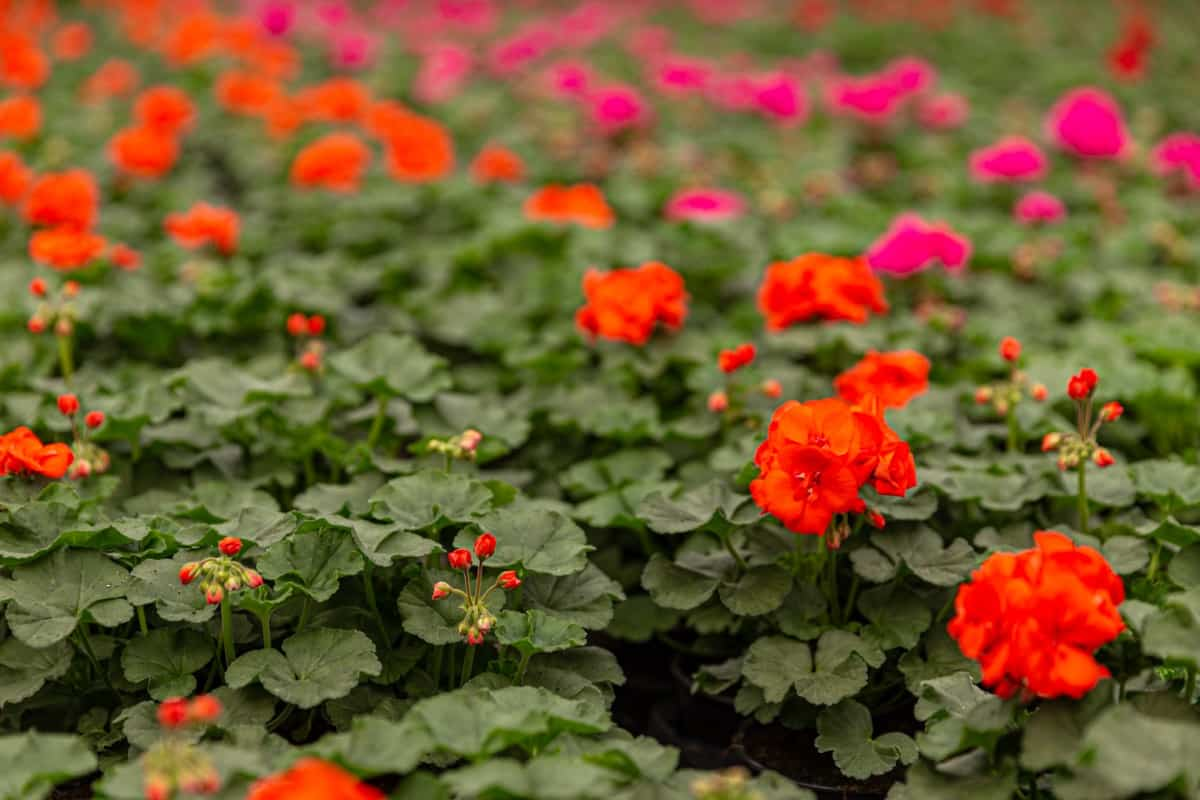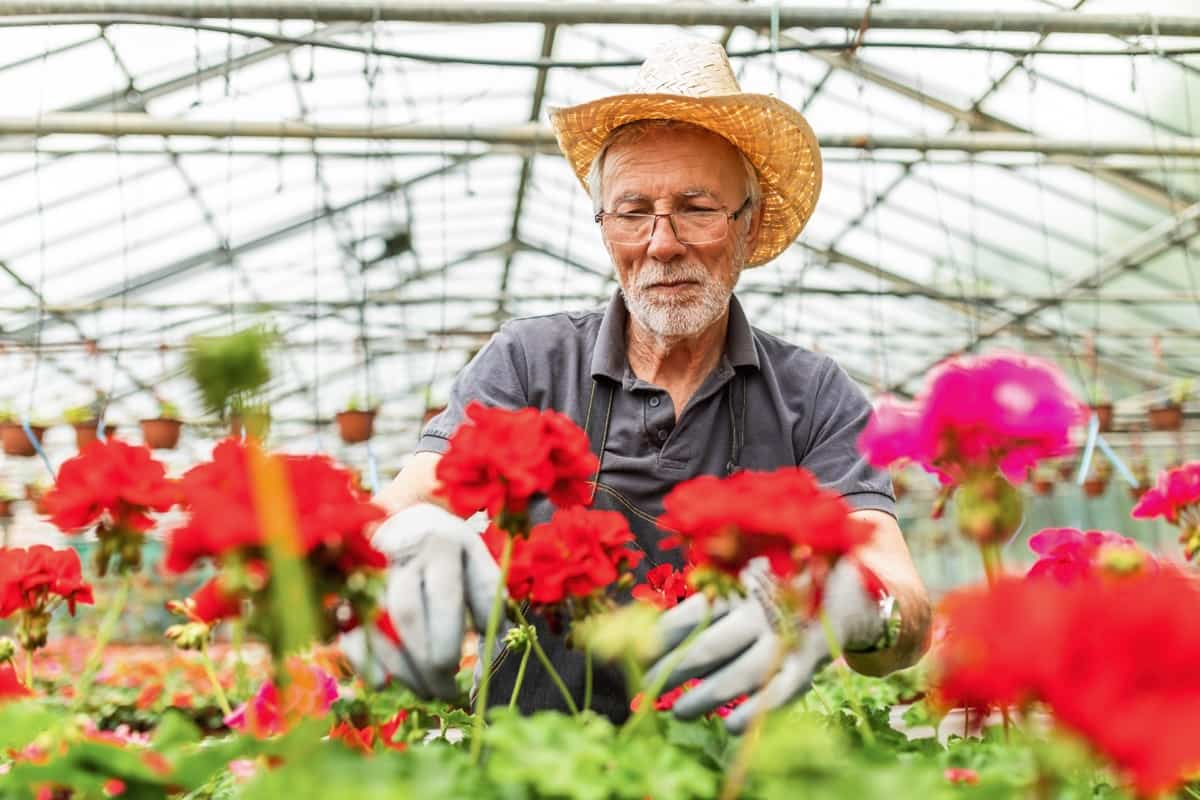Geranium, also called cranesbill, is an important aromatic plant commercially grown for its essential oil. Geranium oil can be found in many fragrances and cosmetic products. Geraniums are among the most beautiful flowers you can grow in a greenhouse. It is no wonder that most greenhouse gardeners have a small patch dedicated to their growth, if not an entire greenhouse.

As a single plant or a group of flowers, they look beautiful when grown in containers. Geraniums are very resilient, so they don’t succumb easily to diseases. Geraniums are easy to grow and care for in greenhouses, and even the least knowledgeable gardener can enjoy their success.
How to Grow Geranium in a Greenhouse
Soil Requirements for Growing Geraniums in Greenhouse
Geraniums grow best in loamy, well-draining soil. The best way to plant geraniums in containers is to use commercial topsoil mixed with sand and a little peat moss. Use compost, peat, or perlite if your soil is heavy.
Sunlight Requirements for Growing Geraniums in Greenhouse
The geranium needs six to eight hours of full sun every day to bloom well. Don’t panic if your plant stops blooming in summer. Geraniums tend to stop flowering during particularly hot weather, so if you live in a hot climate, just move the container to a spot where it will receive some afternoon shade.
Temperature Requirements for Growing Geraniums in Greenhouse
Geraniums can be grown in a wide range of temperatures (7-26°C), but they perform best at warm temperatures. For the production of geraniums using the “Fast Cropping” technique, temperatures between 15 and 18°C at night and 21-24°C during the day are ideal. If temperatures drop below 15°C, growth slows.
Geranium Varieties Suitable for Growing in Greenhouse
- Zonal Geraniums: Their leaves have round patterns, and their flowers are vividly colored. They are used as bedding plants.
- Ivy-Leaved Geraniums: Geraniums with ivy-like leaves will grow along fences and walls. Their leaves are waxy, and their flowers are a variety of colors.
- Fancy-leaved: These Geraniums have wide, variegated leaves with serrated edges.
- Regal: This category consists of shrubby plants with round or lobed leaves and flowers in dark purple or red with solid coloration and no variegation. Angel Pelargoniums are a popular choice for this classification.
- Scented-leaved: Often misidentified as scented geraniums, fragrance-leaved Geraniums have leaves that emit a strong scent when touched. The modern cultivars are available in various scents, including peppermint and lemon.
Growing Geranium In A Greenhouse
- The containers should be filled with potting soil about 1/2 to 1 inch below the rims of the pots.
- The seed coats should be broken before planting by gently scarifying them with an emery board.
- The seeds should be placed two to three inches apart in larger containers or one seed per cell, barely covered with 1/4 inch of potting soil.
- Cover the potting containers with clear plastic wrap once the potting medium has been thoroughly soaked.
- Germination requires soil temperatures of 21-24°C during the day and 15-18°C at night, so place containers in a room with a daytime temperature of 21-24°C and a nighttime temperature of 15-18°C.
- Keep the potting soil moist but not waterlogged by watering when dry.
- When you see the first sprouts, remove the plastic wrap.
- After germination, containers should be placed four to six inches below a 40-watt fluorescent grow light for 12 to 16 hours daily.
- Unless the seedlings are growing in individual cells, thin them out after they have set true leaves. Choose the strongest seedlings in each container and pull up or cut the rest.
- The seedlings may also be potted up in soilless potting medium-filled pots with a six-inch diameter.
- You can dilute houseplant fertilizer and apply it to the seedlings every two weeks at this time.
In case you missed it: How to Start Geranium Farming: A Step-By-Step Planting to Harvest Guide

Watering Requirements for Growing Geraniums in Greenhouse
For geraniums, leave an irrigation furrow around each plant to serve as a watering reservoir since they require thorough and deep watering. As a result, the water pools and then slowly filters through the soil. It is best to let the soil become dry between waterings to avoid root rot. Soaker hoses keep water off the foliage and prevent disease when watered at ground level. You should avoid letting your geraniums wilt to ensure proper geranium plant care. In cycles of wilting and revival, flowers and leaves will not produce well.
Fertilizers Requirements for Growing Geraniums in Greenhouse
Fertilize your geraniums about twice a month to keep them looking bright and beautiful. A good all-purpose fertilizer like 20-20-20 will work well. However, if your plant is not blooming, you might consider purchasing fertilizer with a higher phosphorus concentration. Fertilizer should be applied after your plants have been watered. In the early spring, Geraniums benefit from feeding. During the winter, avoid feeding.
Managing Pests and Diseases in Geraniums Growing in Greenhouse
Healthy Geranium plants are rarely affected by pests or diseases. Nevertheless, oversaturation, inadequate drainage, excessive water on the leaves, and poor spacing of plants may make them susceptible to pests and fungal diseases. Aphids, caterpillars, mealybugs, spider mites, and whiteflies are pests to watch out for. Rinse the insects away with a stream of water from the hose to get rid of them. Alternatively, you can apply neem oil or insecticidal soap if this does not work.
Pruning Geranium Plants Growing in Greenhouse
In early spring, pinch your geranium stems to promote bushiness. After the geranium reaches a few inches, snip or pinch each stem one-quarter to one-half inch long. This way, two new stems will grow from the original geranium, leading to a fuller plant. Geraniums should be pruned in the fall. Leaves and dead, brown, and withered blooms should be removed. A healthy geranium stem feels firm to the touch. It can cause root rot by overwatering or fungal infections by wetting the leaves while watering. Overwatering should be avoided.
Harvesting Geraniums
- A geranium’s life expectancy is about two years, and although they can last longer, they tend to get woody and lose their blooms as they age.
- Once plants are reached 6 inches tall, you can pick individual leaves from them any time during the growing season.
- Harvest leaves with a snip or garden scissors. Branches may be torn or broken if you tear leaves from them.
- A screen should be used to dry the flowers and geraniums. Remove the leaves from the branch later. Leaves and flowers should be stored in airtight containers.
In case you missed it: Top 8 Simple Steps to Germinate Marigold Seeds

Conclusion
Geraniums are mostly grown abroad, and the oil they produce is quite expensive. Approximately 120-130 tonnes of geranium are consumed annually in India, while only 1-2 tonnes are produced. Geranium can therefore be cultivated in greenhouses in light of the high demand. Farmers can also double their income by doing this.
- Feed Your Flock for Less: Top 10 Tips to Save on Chicken Feed
- Ultimate Guide to Ossabaw Island Hog: Breeding, Raising, Diet, and Care
- Hatching Answers: The Top 10 Reasons Your Chickens Aren’t Laying Eggs
- Eggs and Economics: Breaking Down the Cost of Raising Backyard Chickens
- Defend Your Greens: Proven Methods to Keep Iguanas Out of Your Garden
- Ultimate Guide to Cinnamon Queen Chicken: A Comprehensive Guide for Beginners
- Ultimate Guide to California Tan Chicken: Breeding, Raising, Diet, Egg-Production and Care
- Ultimate Guide to Marsh Daisy Chicken: Breeding, Raising, Diet, and Care
- 10 Types of Chicken Farming Businesses You Can Start for Profits